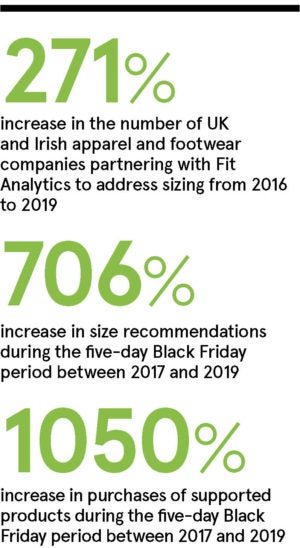In a multichannel environment, customers expect a tailored shopping experience. Online stores have the responsibility to give a personal touch while providing a fast and convenient user experience.
This has led to a trend in the UK of more and more outlets offering personalised and interactive size advice through online channels.
An example of such technology is Fit Analytics, a data-driven software company helping leading global retail brands, including ASOS, Footlocker, Tommy Hilfiger, Calvin Klein and Lacoste, to name a few, solve sizing issues with Fit Finder.
The trend of retailers and brands turning to machine-learning to address user expectations illustrates a general shift in user experience strategies. Apparel customers increasingly expect their favourite brands to offer personalised solutions to help them choose the right size.
For Fit Analytics, this consumer demand drives more than 800 million monthly size recommendations, spanning a portfolio of more than 15 million items across 17,000 brands, and supporting more than £100 billion in global sales and returns.
Machine-learning is the future
When Fit Analytics was founded in 2010, it knew the value of data. The company developed proprietary technologies based on hundreds of thousands of body measurements, which still act as the foundation for its technologies. In 2013, the company introduced a machine-learning approach to its algorithms.
“By learning how to model bodies using different factors, such as gender, height, weight, age and body shape, we were able to combine the measurements with production size charts and sales and returns records to produce accurate recommendations for shoppers seeking size advice,” says Fit Analytics’ chief executive Sebastian Schulze.
Reduced returns, increased conversions, less size sampling, enhanced trust and customer engagement are just a few of the improvements brands look to address
“Standard size charts never did, and still don’t, offer the same accurate size advice as data and machine-learning. After years in the industry, it was clear we could take our technologies a step further.”
Observing the increased importance of machine-learning and responding to client requests for deeper insights, Fit Analytics broadened the scope of its data applications. The company created a data-platform that leverages its industry knowledge to solve issues from various points within the multichannel ecosystem.
Fit Connect followed Fit Finder to address clients’ needs to offer personalisation earlier in the online user journey. Fit Intelligence was created to provide additional insight into shopper preferences, helping retailers develop smarter business strategies. Fit Source rounded out the platform, providing Fit Analytics with its own answer to personalisation, assessing the unique needs of its clients and supporting them with bespoke, uniquely crafted projects.
Dealing with facts, not conjecture
By offering size recommendations and insights based on accurate data, retailers ensure shoppers are better connected with items likely to fit, while simultaneously converting pain points into new revenue opportunities.
Ultimately, it addresses the wider trend of consumer power and expectation and, most significantly, personalisation.
“It is easier to make key decisions that will have a positive business impact if a company knows its customers,” says Fit Analytics’ global head of marketing Alejandro Sáez. “Data helps our clients eliminate confusion around fit and reconcile inconsistencies due to lack of industry sizing standards. The relationship between a shopper and an item becomes clear, replacing conjecture with facts, and ultimately improves profits.”
Mr Sáez cites the example of generational differences with vastly different social and behavioural profiles as evidence of data’s important role, noting that an apparel company marketing to millennials when their customer base primarily comprised of centennials would result in lost conversion opportunity by failing to market effectively to a specific demographic.
The diversity in customer preferences, needs and body shapes is a main driver in this shift to data-driven personalisation. Innovative apparel and footwear companies understand that to offer the most accurate size advice possible, they need to appeal to the individual.
Retailers can be confident that the data behind the recommendations is accurate because the generated advice is based on multiple data sources, including social proof, the aggregate of inputs and preferences given by the customers themselves.
Bridging digital and in-store
Reduced returns, increased conversions, less size sampling, enhanced trust and customer engagement are just a few of the improvements brands look to address.
For the retail industry as a whole, turning to data presents a significant opportunity for companies to offer a way for their customers to make satisfying purchases. Data also bridges the digital and physical divide. With consumers wanting the convenience of online with the personal touch of bricks-and-mortar stores, retailers are more able to address multichannel needs. 
“Sizing solutions offer the personal touch most shoppers are accustomed to when interacting with employees in stores. On the flip side, retailers can use online insights to inform their bricks-and-mortar strategies by adjusting everything from product stock to in-store technologies based on online customer preferences,” says Mr Schulze.
Demand for data-driven approach
For Fit Analytics, the large number of monthly size recommendations produces around 800 million new data points every day. The fact that the company’s number of UK and Irish partners has increased by 271 per cent from 2016 to 2019 shows brands are proactively choosing to partner with industry experts to provide a collaborative, data-driven solution to issues around fit and sizing.
Looking at the busiest time of the year alone, 2019’s five-day Black Friday period saw 2.75 billion page views for Fit Analytics’ clients, amounting to requests from 130 countries, providing 355 million size recommendations and 23 million purchases of supported products.
“With this comprehensive knowledge, we are in the unique position to be able to build products using the largest dataset in the industry,” Mr Schulze concludes. “The retail industry is leaning towards personalisation and we will continue to support apparel and footwear partners looking to leverage data to best serve their customers.”
Want to solve sizing? For more information please visit www.fitanalytics.com
Machine-learning is the future
Dealing with facts, not conjecture



